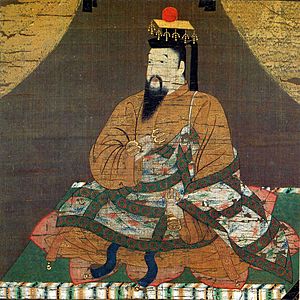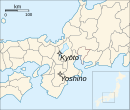Nanboku-chō period facts for kids
The Nanboku-chō period (also called Nambokuchō) was a time in Japanese history when there were two rival Imperial Courts. It started around 1333 or 1336 and ended in 1392. This period is also known as the time of the Northern and Southern Courts.
Contents
History of the Two Courts
For over 60 years in the 1300s, Japan had two different groups claiming to be the true Imperial family. One group, called the Northern Court, was based in Kyoto. These emperors were supported by the Ashikaga shogunate, which was the military government at the time. However, some people questioned if these emperors were truly legitimate rulers.
At the same time, another group, known as the Southern Court, was set up in the Yoshino area, which is now part of Nara Prefecture. The Ashikaga shoguns and their supporters did not accept the emperors from the Southern Court.
Forces loyal to these two rival courts fought against each other for more than six decades. This period of fighting is sometimes seen as the early part of the Muromachi period in Japanese history.
The End of the Conflict
In 1392, the Southern Court decided to stop fighting. It seemed like the Northern Court had won the long struggle. However, later on, scholars and historians argued that the emperors in Kyoto were not the true rulers. This was because they did not have the special Imperial treasures (called regalia) until after 1392. Also, the right to rule was not properly passed to them from Emperor Go-Daigo, who was a Southern Court emperor. The ceremonies to confirm them as emperors were also not considered valid.
In 1911, the Japanese government officially declared that only the emperors of the Southern Court were the true and legitimate rulers during this period.
Northern Court Emperors
These are the emperors who ruled from the Northern Court:
- Emperor Kōgon, 1331–1333
- Emperor Kōmyō, 1336–1348
- Emperor Sukō, 1348–1351
- Emperor Go-Kōgon, 1352–1371
- Emperor Go-En'yū, 1371–1382
- Emperor Go-Komatsu, 1382–1412
Southern Court Emperors
These are the emperors who were officially recognized as the true rulers:
- Emperor Go-Daigo, 1318–1339
- Emperor Go-Murakami, 1339–1368
- Emperor Chōkei, 1368–1383
- Emperor Go-Kameyama, 1383–1392
Related pages
Images for kids
See also
 In Spanish: Período Nanbokuchō para niños
In Spanish: Período Nanbokuchō para niños





